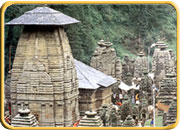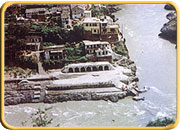Leh Ladakh
Central Ladakh
 A
few kilometres up the Indus is Shey, the most ancient capital, with its palace
and temples, their vibrantly coloured murals cleaned and restored in the mid-1980s.
Down river, Basgo, right on the road and Tingmosgang, a short way up a side-valley,
both served as capital cities when the country was temporarily divided into
two parts in the 15th century, and both have the remains of forts and temples
dating from the period of their brief glory. Stok, just across the river from
Leh, is the village with which the deposed royal family was compensated for
the loss of its throne. Its palace houses a museum of artefacts associated with
the dynasty, and there is also a small gompa.
Of the twelve situated on or near the Inuds, the is Lamayuru, believed to have
been a sacred site for the pre-Buddhist religion known as Bon. Phiyang, Hemis
and Chemrey were all founded under the direct partonage of members of the ruling
Namgyal dynasty. Phiyang represents an act of penance by the 16th century King
Tashi Namgyal for the violence and treachery by which he reached the throne.
Hemis, together with Hanle near the Tibetan border, was founded at the instance
of King Sengge Namgyal, and Chemrey by his widow as a posthumous act of merit
for him. Stakna, dating from a slightly earlier period, was endowed by the Namgyal
kings at various times. All these belong to the red-hat Kar-gyut-pa sect of
Tibetan monasticism.
A
few kilometres up the Indus is Shey, the most ancient capital, with its palace
and temples, their vibrantly coloured murals cleaned and restored in the mid-1980s.
Down river, Basgo, right on the road and Tingmosgang, a short way up a side-valley,
both served as capital cities when the country was temporarily divided into
two parts in the 15th century, and both have the remains of forts and temples
dating from the period of their brief glory. Stok, just across the river from
Leh, is the village with which the deposed royal family was compensated for
the loss of its throne. Its palace houses a museum of artefacts associated with
the dynasty, and there is also a small gompa.
Of the twelve situated on or near the Inuds, the is Lamayuru, believed to have
been a sacred site for the pre-Buddhist religion known as Bon. Phiyang, Hemis
and Chemrey were all founded under the direct partonage of members of the ruling
Namgyal dynasty. Phiyang represents an act of penance by the 16th century King
Tashi Namgyal for the violence and treachery by which he reached the throne.
Hemis, together with Hanle near the Tibetan border, was founded at the instance
of King Sengge Namgyal, and Chemrey by his widow as a posthumous act of merit
for him. Stakna, dating from a slightly earlier period, was endowed by the Namgyal
kings at various times. All these belong to the red-hat Kar-gyut-pa sect of
Tibetan monasticism.Ri-dzong, the only gompa which is not as yet approachable by a motorable road, is situated a few kilometres up a side- valley at Uley-Tokpo. It was founded only a century and a quarter ago by a devout layman-turned-lama, with the purpose of giving full expression to the strict monastic rule of the Ge-lugs-pa. While the paintings and images in its temples may, to some extent, lack the aesthetic and antiquaian interest of those inthe older establishments, this gompa nevertheless has an indefinable atmoshpere of peace and dedication which reflects faithfully the inwardness of the Buddhist Way.
 The
smaller but much older Bying-ma-pa and Saskya-pa monastic sects are represented
respectively by Tak-thok and Matho gompas. Takthok, at the foot of the Chang-la,
incorporates one of the many caves in the Himalaya where the Indian Buddhist
apostle Padma-sambhava is said to have rested and meditated on his journey to
Tibet. Matho Gompa has a slightly rundown structure, but a vibrant religious
community. It is famous for its festival of the oracles which takes place early
in the year, usually in the first half of March.
The
smaller but much older Bying-ma-pa and Saskya-pa monastic sects are represented
respectively by Tak-thok and Matho gompas. Takthok, at the foot of the Chang-la,
incorporates one of the many caves in the Himalaya where the Indian Buddhist
apostle Padma-sambhava is said to have rested and meditated on his journey to
Tibet. Matho Gompa has a slightly rundown structure, but a vibrant religious
community. It is famous for its festival of the oracles which takes place early
in the year, usually in the first half of March.
Select a holiday with us